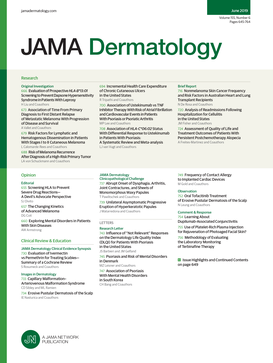Drucker AM, Thibau IJC, Mantell B, Dainty KN, Wyke M, Smith Begolka W. JAMA Dermatol. 2024 Sep 11. doi: 10.1001/jamadermatol.2024.3054.
Key Points
Question What components are essential to include in a patient-centered definition of an atopic dermatitis flare?
Findings In this consensus survey study of 657 US adults with atopic dermatitis (26 completing focus groups and 631 survey participants), 12 statements were agreed on for inclusion in a patient-centered definition of flare. More than half of participants aligned with their health care practitioner on what a flare is, and most reported that a patient-centered definition would be useful when communicating with their health care practitioner.
Meaning These findings suggest that while various definitions of atopic dermatitis flare exist, a patient-centered definition may be useful for clinical practice and research.
Abstract
Importance Flare is a term commonly used in atopic dermatitis (AD) care settings and clinical research, but little consensus exists on what it means. Meanwhile, flare management is an important unmet research and treatment need. Understanding how various therapies might comparatively improve AD flares as a measure of treatment effectiveness may facilitate shared decision-making and enable assessment of effectiveness within and outside clinical settings.
Objective To identify patient-reported attributes associated with an AD flare to develop a patient-centered, consensus-based working definition.
Design, Setting, and Participants This consensus survey study used a modified eDelphi method involving consensus-building focus groups and a survey conducted from January 10 through October 24, 2023. Focus groups were conducted virtually, and the online survey was advertised to National Eczema Association members. US adults aged 18 years or older with AD were recruited via convenience sampling.
Exposure Lived experience of AD.
Main Outcomes and Measures The main outcome was consensus on which attributes of AD to include in a patient-centric definition of flare. Using a rating scale (range, 1-9), consensus for the modified eDelphi statement rating was defined as at least 70% of participants rating a statement as 7 to 9 (critical to a flare definition) and less than 15% rating it as 1 to 3 (not important).
Results Twenty-six participants with AD who completed focus group activities (24 aged 18-44 years [92.3%] and 2 aged 45-64 years [7.7%]; 18 women [69.2%]) and 631 participants with AD (mean [SD] age, 45.5 [18.1] years; 533 women [84.5%]) who completed the survey were included in the analysis. Fifteen statements reached consensus from the focus groups, and of those, 12 reached consensus from survey participants. More than half (334 of 631 [52.9%]) of survey participants reported alignment with their health care practitioner on what a flare is, and most (478 of 616 [77.6%]) reported that a patient-centered definition would be useful when communicating with their health care practitioner about their condition.
Survey Participant Ranking of 15 Statements Compared With One Another
Conclusions and Relevance In this study, participants with AD reached consensus on what an AD flare means from the patient perspective. This understanding may improve research and care by addressing this key patient-centered aspect of evaluating treatment effectiveness.

No comments:
Post a Comment